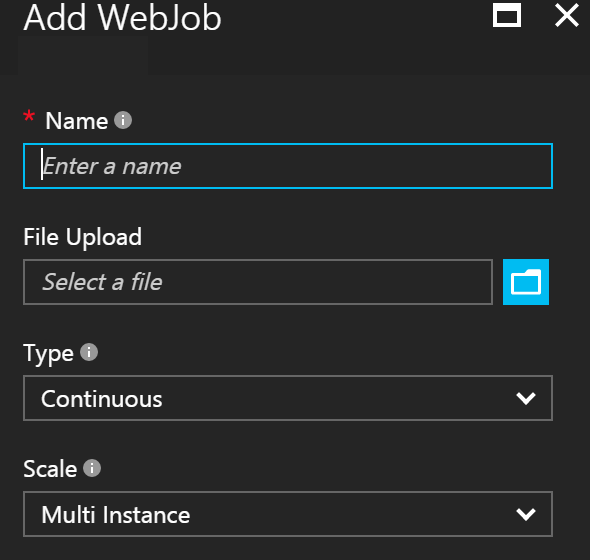Building and deploying Azure WebJobs with F#
If you have read some of my other posts you know that F# is a favorite languge of mine so when I was going to create an Azure WebJob to handle messages from the Azure ServiceBus it felt natural to write it using F#. It all seemed as a great idea but along the way I found some issues both with the building and with the deployment which I tought I would share.
The building part
The first issue occure right away, I had just installed Visual Studio 2017 and all the Azure tools but there is no template for WebJobs and F# only for C#. But a WebJob is just a console application so I started of by creating a new console application.
My case was a very simple one, I was going to listen for messages on a Azure ServiceBus Topic and then relay that message to a given API endpoint.
Packages
To create a WebJob you need a Nuget package so I simply installed it:
Install-Package Microsoft.Azure.WebJobs
Since I also needed to listen for messages on the ServiceBus I also needed the nuget package for that:
Install-Package Microsoft.Azure.WebJobs.ServiceBus
Configuration
The configuration of the WebJob is very simple, in my Program.cs file I created a new instance of the class JobHostConfiguration. The ServiceBus integration is added by an extension method for the config object by calling UseServiceBus().
Then you need to create a host and pass in the configuration.
open Microsoft.Azure.WebJobs
[<EntryPoint>]
let main argv =
let config = new JobHostConfiguration()
config.UseServiceBus()
let host = new JobHost(config)
host.RunAndBlock()
0
Listening for messages
The simpliest way to listen for messages is to create a function with a parameter that represents the incoming message and decorate that parameter with an attribute called ServiceBusTrigger. The attribute takes two arguments, the first being the name of the Topic and the other is which Subscription to use.
I created a new module to contain my function, the function can also take another argument of type TextWriter which lets you log information which will be avaiable to view in the Azure portal.
open Microsoft.Azure.WebJobs
module Listener =
let ProcessMessage ([<ServiceBusTrigger("[topicname]", "[subscription]")>] message : string) (log : TextWriter) =
()
As long as you function is public it will automatically be discovered when the program runs as the entry point of the message from the ServiceBus.
I knew that the incoming message was going to be in a JSON format so I wrote a simple message parser that checks the message for information about what type of message is is and the parser returns a discriminated union with typed information about the message so I could use pattern matching to decide what to do with the message:
match MessageParser.parse message with
| UserAdded info -> info |> sendUserAddedInfo
| Empty -> log.Info "Recieved empty message"
| Unknown msg -> log.Info <| sprinf "Unknown message: %s" msg
The sendUserAddedInfo is just a HTTP call that takes the message and passes it to another API.
Deploying
Now if we had created a C# console application we could have just right clicked on our project i Visual Studio and selected Publish and published our WebJob from there but for some reason there is no Publish option for F# console applications.
After a lot of googeling I found out that when pulishing a WebJob all you have to do is create a .zip file of the output in your bin/Release folder. In a production scenario it’s recommended to let a deploy system like Octupus Deploy take care of this for you but for the purpose of this blog post lets just create a .zip file of the output in your release folder.
The next step is to go to the Azure portal and create a new app service and you will also need a storage account. Once the app service is created you have a menu option called “WebJobs” if you click there and selects “+Add” in the top menu you will get a small menu (see picture).

Give the WebJob a name and under “File upload” select the .zip file you created of the build output.
In my case I was going to continously listen for messages on the ServiceBus so my WebJob was of the the type “Continous” but you can also create a WebJob that runs like a CRON job.
If you don’t want to store connection strings in a .config file in your code you can set these in the “Application settings” for the app service we created.
Summary
As shown it is possible to work with WebJobs using F# but the workflow isn’t as polished as it is for C#. One might wonder why but I can’t shake of the feeling that Microsoft isn’t paying F# as much attention as it deserves, I guess we just have to wait and see if the F# community might fill the gap or we will have to wait for Microsoft to catch up.
Written on March 23rd , 2017 by Robin Ridderholt